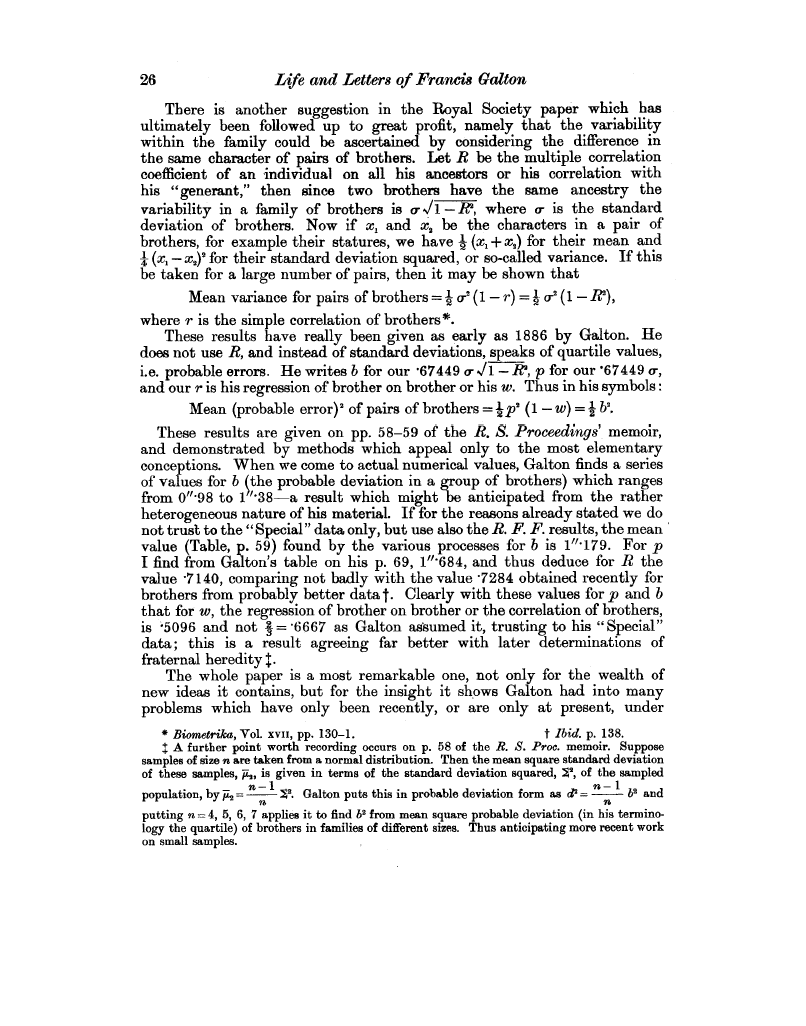| ||||||

OCR Rendition - approximate
26 Life and Letters of Francis Galton There is another suggestion in the Royal Society paper which has ultimately been followed up to great profit, namely that the variability within the family could be ascertained by considering the difference in the same character of pairs of brothers. Let R be the multiple correlation coefficient of an individual on all his ancestors or his correlation with his "generant," then since two brothers have the same ancestry the variability in a family of brothers is o .J1- R', where a- is the standard deviation of brothers. Now if x, and x, be the characters in a pair of brothers, for example their statures, we have 2 (x1 + x,) for their mean and I (x, - x,)' for their standard deviation squared, or so-called variance. If this be taken for a large number of pairs, then it may be shown that Mean variance for pairs of brothers = 2 a-' (1- r) = 2 0-2 (1- R'), where r is the simple correlation of brothers*. These results have really been given as early as 1886 by Galton. He does not use R, and instead of standard deviations, speaks of quartile values, i.e. probable errors. He writes b for our •67449 a-,/1 -R', p for our '67449 o-, and our r is his regression of brother on brother or his w. Thus in his symbols Mean (probable error)' of pairs of brothers = sp2 (1 - w) =2 b2. These results are given on pp. 58-59 of the R. S. Proceedings' memoir, and demonstrated by methods which appeal only to the most elementary conceptions. When we come to actual numerical values, Galton finds a series of values for b cthe probable deviation in a group of brothers) which ranges from 0"•98 to 1'•38-a result which might be anticipated from the rather heterogeneous nature of his material. If for the reasons already stated we do not trust to the "Special" data only, but use also the R. F. F. results, the mean value (Table, p. 59) found by the various processes for b is 1"•179. For p I find from Galton's table on his p. 69, 1"•684, and thus deduce for R the value •7140, comparing not badly with the value •7284 obtained recently for brothers from probably better data t. Clearly with these values for p and b that for w, the regression of brother on brother or the correlation of brothers, is `5096 and not 3 ='6667 as Galton assumed it, trusting to his "Special" data; this is a result agreeing far better with later determinations of fraternal heredity +. The whole paper is a most remarkable one, not only for the wealth of new ideas it contains, but for the insight it shows Galton had into many problems which have only been recently, or are only at present, under * Biometrika, Vol. xvn, pp. 130-1. t Ibid. p. 138. $ A further point worth recording occurs on p. 58 of the R. S. Proc. memoir. Suppose samples of size n are taken from a normal distribution. Then the mean square standard deviation of these samples, µ„ is given in terms of the standard deviation squared, Y,', of the sampled population, by µ, = n-1 :~'. Galton puts this in probable deviation form as d2 = n-1 b' and n n putting n = 4, 5, 6, 7 applies it to find bz from mean square probable deviation (in his terminology the quartile) of brothers in families of different sizes. Thus anticipating more recent work on small samples.
|